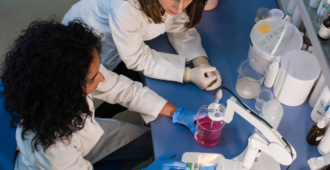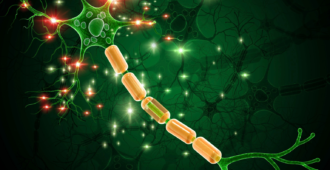There’s a scene in the 1969 film Battle of Britain where Laurence Olivier, who plays the Air Chief Marshal, is in a meeting with his two Vice Marshals. One of them complains that they don’t have enough planes; the other is more concerned with keeping the airfields working. Olivier silences them both by telling them that the fight will be won or lost on one key factor – the number of trained pilots.
It’s a rather cheesy film, but I used that story earlier this month to illustrate the importance of investing in bringing through the next generation of researchers in our battle to defeat MND. We organised a ‘get together’ of our Lady Edith Wolfson Clinical Fellows at the Sheffield Institute for Translational Neuroscience (SITraN) to share their research findings with the donor who has so generously supported the scheme. The ‘get together’ also provided a wonderful opportunity for them to exchange information and expertise with each other, as well as all the staff of SITraN, who over the course of the day were frequently shuttling between the lecture room and their labs.
The Fellowships are aimed at attracting and training the brightest and the best Clinician-Scientists (or ‘Doctor-Doctors’ as I sometimes call them – with both a medical degree and a science PhD). Even so, I couldn’t resist using this cartoon in my introduction, although the reality is very different for our Fellows – the bar is set very high and even applicants for the Junior Fellowships need to have considerable research experience and be fully ‘lab tested’.
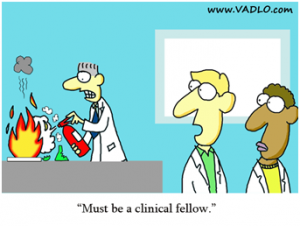
Our host for the day was one of the world’s most respected MND ‘Doctor-Doctors’, SITraN Director Prof Pam Shaw, who welcomed everyone to the meeting and provided an overview of the multidisciplinary expertise and collaborative philosophy that underpins SITraN. Prof Shaw also has a great belief in the importance of nurturing the next generation of talent and it is no surprise that almost half of the Clinical Fellows in the programme are based at SITraN.
Are fit and active people more likely to develop MND?
Our first research presentation was from Dr Ceryl Harwood (Sheffield) who is carrying out research on the epidemiology of MND. Specifically, she is addressing the question of whether physical activity is a risk factor for MND. As she explained, this has been a long standing theory, showing us a quote from a medical journal written over 50 years ago which stated:
”Nothing has been said about the possible role in aetiology of a previous habit of athleticism. I have the uncomfortable feeling that a past history of unnecessary muscular movement carried out for no obvious reason may be followed in later life by the development of motor neurone disease in a statistically significant number of cases”
She outlined the plausibility that physical activity may contribute to a complex interplay between biological and genetic processes that may predispose an individual to develop the disease. Generating the evidence, however, is no easy matter, but she has developed and validated a novel questionnaire to measure physical history in adulthood, using data from a diabetes study in the 1990s where over 1,000 people had detailed measures taken of their actual energy expenditure.
A hundred of these participants have recently agreed to undergo rigorous face-to-face interviews and their responses were correlated with actual physical measures from over 15 years previously. In other words, she can now assess how accurately peoples’ recollection of their physical activity – both day to day work and vigorous exercise – links with their actual energy expenditure at the time. This questionnaire is now being used to compare the physical activity profiles in up to 350 people with MND and 700 control participants in Yorkshire and surrounding counties.
Should the results support the theory that physical activity is a predisposing factor in MND, she will be perfectly placed to delve into the genetic factors that underpin the selective vulnerability of motor neurons.
Repetition is bad….
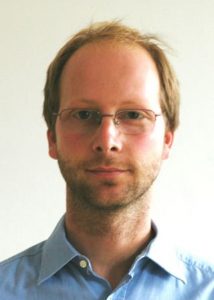
Next up to the lectern was Dr Pietro Fratta, (University College London) who has been immersing himself in the mysteries of how the C9orf72 gene can cause neurodegeneration – especially MND and a related condition called Frontotemporal Dementia (FTD).
Like a needle on a vinyl record can sometimes stick and repeat the same fragment of music again and again, this gene sometimes carries a repeat in its genetic code – specifically with the letters GGGGCC occurring again and again. Dr Fratta has examined many DNA samples from MND and FTD patients and finds that these ‘repeat expansions’ are very large indeed, occurring between 700 and 4000 times!
The process through which these repeat expansions cause nerves to die is still a mystery, but Dr Fratta showed results from his lab which suggests that rather than losing its normal function, the C9orf72 gene gains some additional activity, turning it into a ‘rogue’ gene. He and his colleagues have recently shown that the repeat expansions can lead to the formation of very stable chemical structures called G-quadruplexes that have been implicated in causing nerve damage in other disorders.
He is currently studying how these structures interact with other cellular components, interfering with normal neuronal function. He is also starting to look at possible therapeutic approaches in a collaboration with the UCL School of Pharmacy to develop compounds that will bind to and hopefully inactivate these structures.
Over lunch, we were given a guided tour of the superb SITraN labs by Prof Shaw. Although I strongly believe that research is only as good as the researchers doing the work, there’s no doubt that having a purpose built institute filled with state-of-the art technology certainly doesn’t do any harm!
Then it was back into the lecture room for our afternoon presenters.
A Sheffield double act
The post-lunch session was kicked off by Dr Robin Highley, a neuropathologist who has recently completed his Fellowship and now divides his time equally between pathology duties and MND research. Dr Highley’s area of expertise is in how neurons edit the genetic instructions into precise ‘blueprints’ to make proteins, the essential building blocks of every cell in our body.
He used an entertaining analogy of making dresses form a pattern to describe the process of how DNA is made into RNA copies which can be ‘tailored’ into slightly different protein designs (to find out more about how DNA makes RNA and subsequently proteins see our earlier blog post).
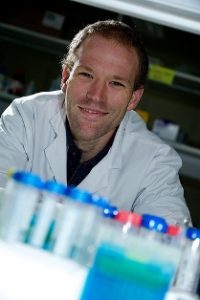
Using a variety of approaches he has looked at gene expression (which genes are being switched on and off) and gene splicing (how the RNA copies are edited) patterns in both inherited and non-inherited MND, as well as in non-MND states. He finds changes occurring in thousands of genes, but by performing searches on databases of the ‘function’ of each gene he can then sort them into different groups (which are then involved in key cellular processes). This provides important clues as to which cellular pathways are altered in MND, which will help researchers around the world to focus their attention on the most common changes and hopefully start addressing the question of how these may be slowed or stopped.
Dr Highley focused his talk mainly on the TDP-43 and SOD1 forms of inherited MND, with his colleague and fellow ‘Fellow’(!) Dr Johnathan Cooper-Knock, concentrating on the C9orf72 form (the most common cause of inherited MND). Through the MND Association’s DNA Bank he has been able to obtain a large number of cell lines from patients with C9orf72 MND, along with detailed clinical information, which will allow him to compare patterns between those with fast progressing and those with more slowly progressing disease.
Although at a much earlier stage in his research, having started only 6 months ago, Dr Cooper-Knock has already identified some specific gene expression effects that may be distinct to the C9orf72 form of the disease. For more details about Dr Cooper-Knock’s work see our earlier blog post about his fellowship.
BioMOx and beyond
It was fitting that Dr Martin Turner (Oxford) gave the closing presentation. Not only was Dr Turner the first recipient of a Lady Edith Wolfson Fellowship, but he has recently been awarded a new five-year Senior Clinical Fellowship through the programme – these are highly prestigious awards, with only one in seven applicants successful.
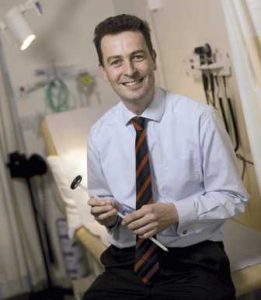
Titling his talk ‘BioMOx and beyond’ Dr Turner outlined the challenge of identifying a specific signature of MND. He showed that whilst there is unlikely to be a single test for MND, a combination of tests (involving brain scanning and eye tracking techniques together with chemical analysis of blood, urine or cerebrospinal fluid) are showing some promise in aiding and speeding up the diagnosis, as well as predicting how the disease is likely to progress within an individual.
He highlighted the importance of international collaboration, such as the new formal link with Dr Mike Benatar in Miami, who for several years has been studying people at risk of developing inherited MND. Indeed, Dr Turner apologised for missing the morning speakers at Sheffield as he had been busy with one of Dr Benatar’s study participants in his MRI scanner at Oxford!
On the subject of international collaboration, our most recent Clinical Fellow, Dr Jemeen Sreedharan, was unfortunately unable to attend as the first two years of his Fellowship is based at the University of Massachusetts, returning to the University of Cambridge to complete his research. We look forward to having him at the next Fellows get-together!


